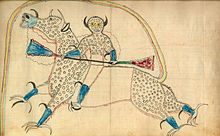Ledger Art
Ledger Art is the designation for a graphic art movement of the Plains Indians , roughly between 1865 and 1935. There are drawings and paintings on paper with pencil, ink, crayon or chalk, rarely colored with watercolors. The name is derived from the English term for account books, the ledger books . For the Plains Indians of the 19th century, the account books of the Anglo-American settlers and the US Army were the first and most important source of paper. There are Indian artists who maintain this art direction to this day.
Historical precursors
Ledger Art developed from painting on dried animal skins. Among the Plains Indians, women painted geometric designs and men painted representational motifs. Shields, tepees, shirts, leggings and dresses were often painted. The most common motives were heroic deeds in wars and on the hunt.
Heyday

The most famous Ledger Art artists were Native American prisoners of war at Fort Marion in St. Augustine , Florida. In 1874, Cheyenne , Kiowa , Comanche , Arapaho and Caddo warriors fought against the US Army in the Red River War and Buffalo War, respectively, to defend the last free herd of buffalo in the region and thus gain independence to back up. In the harsh winter of 1874 to 1875, many tribal camps were forced to surrender. The leaders were taken to Fort Marion prison. From 1875 to 1878, 71 men and one woman were under the command of Captain Richard Henry Pratt , who provided education for the Indians in white American culture. He also supplied the Indians with pencils, ink, chalks, watercolors and paper.
26 of the prisoners were engaged in drawing and painting. Some of Fort Marion's most famous artists were: Paul Caryl Zotom (Kiowa), David Pendleton Oakerhater or Making Medicine (Cheyenne), Tichtematse or Squint Eyes (Cheyenne), Wohaw (Kiowa), Howling Wolf (Cheyenne), Etahdleuh Doanmoe (Kiowa) , White Bear (Arapaho), Koba (Kiowa) and Bear's Heart (Cheyenne). Tichtematse, Howling Wolf, White Bear, and Koba continued to draw after they were released from prison.
A particularly well-known representative of the Ledger Art was Black Hawk . He drew 76 color graphics about Lakota life as well as about his spiritual visions. His drawings are considered the most complete collection of Lakota art in the early reservation period and unique historical and cultural documents.
today
Numerous contemporary Indian artists produce works of art in the style of Ledger Art. Dwayne Wilcox ( Oglala Lakota ) uses this style to depict humorous aspects of contemporary Lakota life. Arthur Amiotte (Oglala Lakota) uses Ledger Art on his collages, where he combines texts, photographs, naturalistic painting and stylized drawings.
literature
- Karen D. Petersen: Plains Indian Art from Fort Marion, University of Oklahoma Press, 1971
- J. Berlo, ed., Harry N. Abrams: Plains Indian Drawings 1865-1935: Pages from a Visual History, New York, 1976
- Greene, Candace S. Silver Horn: Master Illustrator of the Kiowas. Norman: University of Oklahoma Press, 2001. ISBN 0-8061-3307-4 .
- Hansen, Emma I. Memory and Vision: Arts, Cultures, and Lives of Plains Indian People. Cody, WY: Buffalo Bill Historical Center, 2007. ISBN 0-295-98580-1 .
- Swan, Daniel C. Peyote Religious Art: Symbols of Faith and Belief. Jackson: University of Mississippi Press, 1999. ISBN 1-57806-096-6 .
- Szabo, Joyce M. Art from Fort Marion: The Silberman Collection. Norman: University of Oklahoma Press, 2007. ISBN 978-0-8061-3883-1 .
Web links
Individual evidence
- ^ Hansen, Emma I. Memory and Vision: Arts, Cultures, and Lives of Plains Indian People. Cody, WY: Buffalo Bill Historical Center, 2007. ISBN 0-295-98580-1
- ↑ a b c d e Szabo, Joyce M. Art from Fort Marion: The Silberman Collection. Norman: University of Oklahoma Press, 2007. ISBN 978-0-8061-3883-1
- ↑ Janet Catherine Berlo: Spirit Beings and Sun Dancers: Black Hawk's Vision of the Lakota World . George Braziller in association with the New York State Historical Association, New York, NY 2000, ISBN 0-8076-1465-3 .


